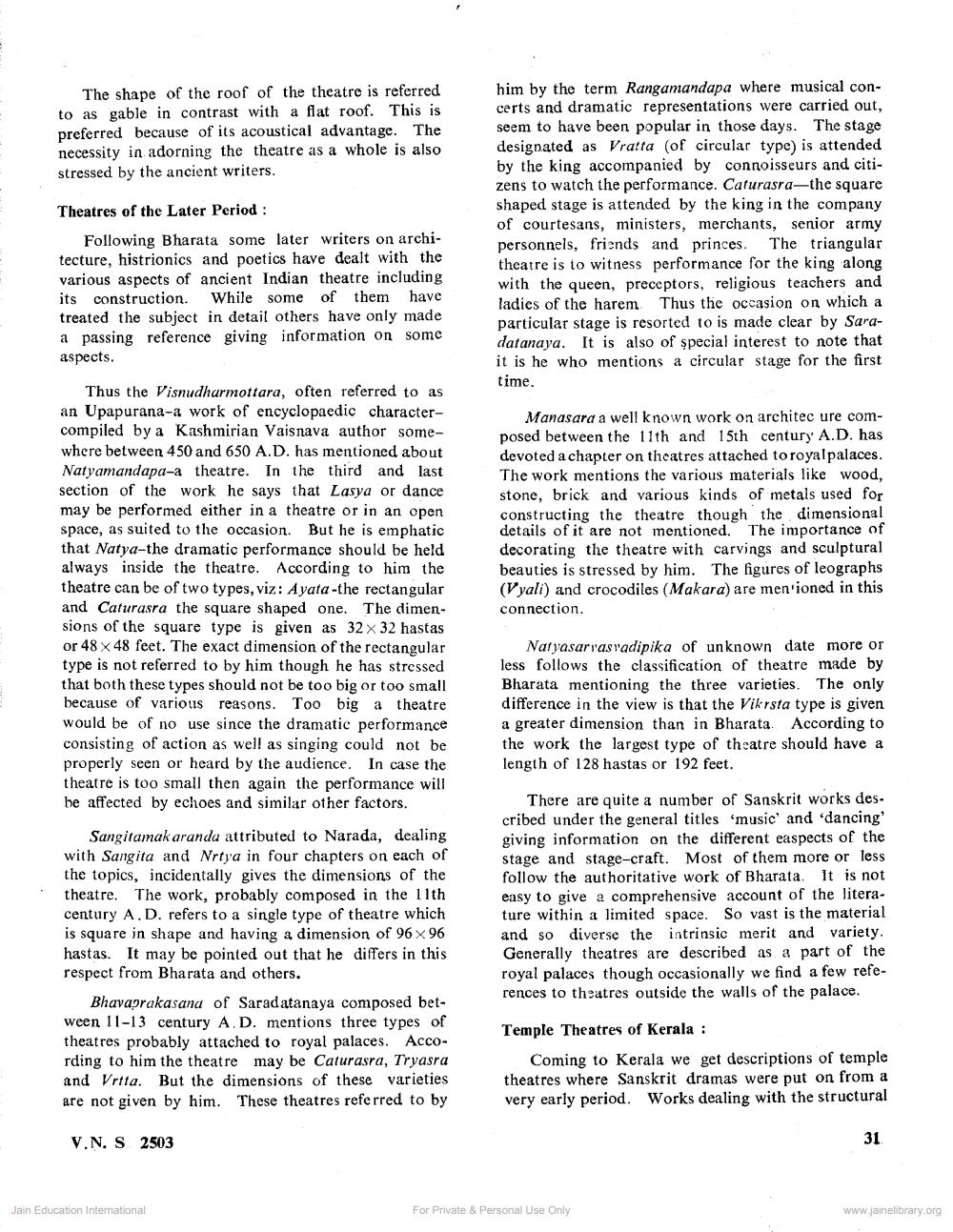Book Title: Evolution of the Sanskrit Stage Author(s): N P Unni Publisher: Z_Rajendrasuri_Janma_Sardh_Shatabdi_Granth_012039.pdf View full book textPage 3
________________ The shape of the roof of the theatre is referred to as gable in contrast with a flat roof. This is preferred because of its acoustical advantage. The necessity in adorning the theatre as a whole is also stressed by the ancient writers. Theatres of the Later Period: Following Bharata some later writers on architecture, histrionics and poetics have dealt with the various aspects of ancient Indian theatre including its construction. While some of them have treated the subject in detail others have only made a passing reference giving information on some aspects. him by the term Rangamandapa where musical concerts and dramatic representations were carried out, seem to have been popular in those days. The stage designated as Vratta (of circular type) is attended by the king accompanied by connoisseurs and citizens to watch the performance. Caturasra—the square shaped stage is attended by the king in the company of courtesans, ministers, merchants, senior army personnels, friends and princes. The triangular theatre is to witness performance for the king along with the queen, preceptors, religious teachers and ladies of the harem Thus the occasion on which a particular stage is resorted to is made clear by Saradatanaya. It is also of special interest to note that it is he who mentions a circular stage for the first time. Thus the Visnudharmottara, often referred to as an Upapurana-a work of encyclopaedic charactercompiled by a Kashmirian Vaisnava author somewhere between 450 and 650 A.D. has mentioned about Natyamandapa-a theatre. In the third and last section of the work he says that Lasya or dance may be performed either in a theatre or in an open space, as suited to the occasion. But he is emphatic that Natya-the dramatic performance should be held always inside the theatre. According to him the theatre can be of two types, viz: Ayata-the rectangular and Caturasra the square shaped one. The dimensions of the square type is given as 32 x 32 hastas or 48 x 48 feet. The exact dimension of the rectangular type is not referred to by him though he has stressed that both these types should not be too big or too small because of various reasons. Too big a theatre would be of no use since the dramatic performance consisting of action as well as singing could not be properly seen or heard by the audience. In case the theatre is too small then again the performance will be affected by echoes and similar other factors. Manasara a well known work on architec ure composed between the 11th and 15th century A.D. has devoted a chapter on theatres attached to royalpalaces. The work mentions the various materials like wood, stone, brick and various kinds of metals used for constructing the theatre though the dimensional details of it are not mentioned. The importance of decorating the theatre with carvings and sculptural beauties is stressed by him. The figures of leographs (Vyali) and crocodiles (Makara) are mentioned in this connection. Naryasarvasvadipika of unknown date more or less follows the classification of theatre made by Bharata mentioning the three varieties. The only difference in the view is that the Vikrsta type is given a greater dimension than in Bharata. According to the work the largest type of theatre should have a length of 128 hastas or 192 feet. Sangitamak aranda attributed to Narada, dealing with Sangita and Nrtya in four chapters on each of the topics, incidentally gives the dimensions of the theatre. The work, probably composed in the 11th century A.D. refers to a single type of theatre which is square in shape and having a dimension of 96 x 96 hastas. It may be pointed out that he differs in this respect from Bharata and others. Bhavaprakasand of Saradatanaya composed between 11-13 century A.D. mentions three types of theatres probably attached to royal palaces. According to him the theatre may be Caturasra, Tryasra and Vrtta. But the dimensions of these varieties are not given by him. These theatres referred to by There are quite a number of Sanskrit works described under the general titles music and dancing' giving information on the different easpects of the stage and stage-craft. Most of them more or less follow the authoritative work of Bharata. It is not easy to give a comprehensive account of the literature within a limited space. So vast is the material and so diverse the intrinsic merit and variety. Generally theatres are described as a part of the royal palaces though occasionally we find a few references to theatres outside the walls of the palace. Temple Theatres of Kerala : Coming to Kerala we get descriptions of temple theatres where Sanskrit dramas were put on from a very early period. Works dealing with the structural V.N S 2503 31 Jain Education Intemational For Private & Personal Use Only www.jainelibrary.orgPage Navigation
1 2 3 4
